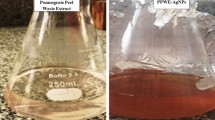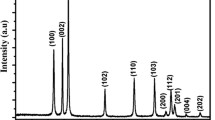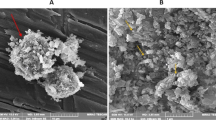Abstract
Pathogenic bacteria in food are a public health problem worldwide. Polyphenolic bioactive compounds with antimicrobial activity and antioxidant capacity represent a tangible alternative to overcome this problem. To preserve the biological functions of phenolic compounds such as tannic acid, which has been described to possess antioxidant and antimicrobial activity, this study describes the synthesis of a zinc nanohydroxide to stabilize its properties. Characterization by XRD, FT-IR, SEM, DLS, and UV-vis evidenced the presence of tannic acid in the nanohybrid TA-Zn-LHS which was further confirmed by DPPH, ABTS and FRAP antioxidant activity techniques. Bacterial growth inhibition of Escherichia coli ATCC 8739, Salmonella Enteritidis, and Staphylococcus aureus ATCC 25923 was over 80% at 50 mg/mL of the TA-Zn-LHS and over 90% with Zn-LHS. Antibiofilm evaluation of these same strains showed biofilm formation inhibition > 90% and > 80% for Zn-LHS and TA-Zn-LHS, respectively. The toxicity evaluation of the materials in Artemia salina showed a classification of the materials as non-toxic to slightly toxic in concentrations up to 1 mg/mL. These results allow us to introduce a new nanohybrid useful for food safety with safe biological functions.



Similar content being viewed by others
Data availability
The data supporting this research is available upon reasonable request to the corresponding author’s email address.
Code availability
Not applicable.
Abbreviations
- ABTS:
-
2,2′-Azino-bis(3-ethylbenzothiazoline-6-sulfonate)
- DLS:
-
Dynamic light scattering
- DPPH:
-
2,2 Diphenyl-1-picrylhydrazyl
- FRAP:
-
Ferric reducing antioxidant power
- FT-IR:
-
Fourier transform infrared spectroscopy
- LHS:
-
Layered hydroxide salt
- OD:
-
Optical density
- SEM:
-
Scanning electron microscopy
- TA:
-
Tannic acid
- XRD:
-
X-ray diffraction
References
Abendrot M, Kalinowska-Lis U (2018) Zinc-containing compounds for personal care applications. Int J Cosmet Sci 40(4):319–327. https://doi.org/10.1111/ics.12463
Baig MM, Hassan M, Ali T, Asif HM, Asghar A, Ullah S, Alsafari IA, Zulfiqar S (2022) Green 2D simonkolleite/zinc based nanostructures for superior antimicrobial and photocatalytic applications. Mater Chem Phys 287:126292. https://doi.org/10.1016/j.matchemphys.2022.126292
Balouiri M, Sadiki M, Ibnsouda SK (2016) Methods for in vitro evaluating antimicrobial activity: a review. J Pharm Anal 6(2):71–79. https://doi.org/10.1016/j.jpha.2015.11.005
Benzie IF, Strain JJ (1996) The ferric reducing ability of plasma (FRAP) as a measure of “antioxidant power”: the FRAP assay. Anal Biochem 239:70–76. https://doi.org/10.1006/abio.1996.0292
Bhattacharya A (2019) High-temperature stress and metabolism of secondary metabolites in plants. Effect of high temperature on crop productivity and metabolism of macro molecules. Elsevier, pp 391–484. https://doi.org/10.1016/B978-0-12-817562-0.00005-7
Bouaziz Z, Soussan L, Janot JM, Jaber M, Ben Haj Amara A, Balme S (2018) Dual role of layered double hydroxide nanocomposites on antibacterial activity and degradation of tetracycline and oxytetracyline. Chemosphere 206:175–183. https://doi.org/10.1016/j.chemosphere.2018.05.003
Brand-Williams W, Cuvelier ME, Berset C (1995) Use of a free radical method to evaluate antioxidant activity. Food Sci Technol 28(1):25–30. https://doi.org/10.1016/S0023-6438(95)80008-5
Carbajal-Arízaga GG, Satyanarayana K, Wypych F (2007) Layered hydroxide salts: synthesis, properties and potential applications. Solid State Ion 178(15–18):1143–1162. https://doi.org/10.1016/j.ssi.2007.04.016
Casas-Junco PP, Solís-Pacheco JR, Ragazzo-Sánchez JA, Aguilar-Uscanga BR, Bautista-Rosales PU, Calderón-Santoyo M (2019) Cold plasma treatment as an alternative for ochratoxin a detoxification and inhibition of mycotoxigenic fungi in roasted coffee. Toxins 11(6):337. https://doi.org/10.3390/toxins11060337
Chen C, Yang H, Yang X, Ma Q (2022) Tannic acid: a crosslinker leading to versatile functional polymeric networks: a review. RSC Adv 12(13):7689–7711. https://doi.org/10.1039/d1ra07657d
Danabas D, Ates M, Tastan BE, Cimen ICC, UnalI AO, Kutlu B (2020) Effects on Zn and ZnO nanoparticles on Artemia salina and Daphnia magna organisms: toxicity, accumulation and elimination. Sci Total Environ 711:134869. https://doi.org/10.1016/j.scitotenv.2019.134869
Gülçin İ, Huyut Z, Elmastaş M, Aboul-Enein HY (2010) Radical scavenging and antioxidant activity of tannic acid. Arab J Chem 3(1):43–53. https://doi.org/10.1016/j.arabjc.2009.12.008
Kaczmarek B (2020) Tannic acid with antiviral and antibacterial activity as a promising component of biomaterials-a minireview. Materials. https://doi.org/10.3390/ma13143224
Lancheros RJ, Beleño JÁ, Guerrero CA, Godoy-Silva RD (2014) Producción de nanopartículas de plga por el método de emulsión y evaporación para encapsular N-acetilcisteína (NAC). Univ Sci 19(2):161–168. https://doi.org/10.11144/Javeriana.SC19-2.pnpm
Li H, Wang X, Li Y, Li P, Wang H (2009) Polyphenolic compounds and antioxidant properties of selected China wines. Food Chem 112(2):454–460. https://doi.org/10.1016/j.foodchem.2008.05.111
Mohsin SMN, Hussein MZ, Sarijo SH, Fakurazi S, Arulselvan P, Hin TYY (2013) Synthesis of (cinnamate-zinc layered hydroxide) intercalation compound for sunscreen application. Chem Cen J 7(1):1–12. https://doi.org/10.1186/1752-153X-7-26
Nakagaki S, Machado GS, Stival JF, Henrique dos Santos E, Silva GM, Wypych F (2021) Natural and synthetic layered hydroxide salts (LHS): recent advances and application perspectives emphasizing catalysis. Prog Solid State Ch 64:100335. https://doi.org/10.1016/j.progsolidstchem.2021.100335
O’Toole GA (2011) Microtiter dish biofilm formation assay. J vis Exp. https://doi.org/10.3791/2437
Orlowski P, Zmigrodzka M, Tomaszewska E, Ranoszek-Soliwoda K, Czupryn M, Antos-Bielska M, Szemraj J, Celichowski G, Grobelny J, Krzyzowska M (2018) Tannic acid-modified silver nanoparticles for wound healing: the importance of size. Int J Nanomedicine 13:991–1007. https://doi.org/10.2147/IJN.S154797
Pucci C, Martinelli C, De Pasquale D, Battaglini M, di Leo N, Degl’Innocenti A, Ciofani G, (2022) Tannic Acid–iron complex-based nanoparticles as a novel tool against oxidative stress. ACS Appl Mater Interfaces 14(14):15927–21594. https://doi.org/10.1021/acsami.1c24576
Raajshree KR, Durairaj B (2017) Evaluation of the antityrosinase and antioxidant potential of zinc oxide nanoparticles synthesized from the brown seaweed–turbinaria conoides. Int J Appl Pharm 9(5):116–120. https://doi.org/10.22159/ijap.2017v9i5.20847
Rezaei A, Fathi M, Jafari SM (2019) Nanoencapsulation of hydrophobic and low-soluble food bioactive compounds within different nanocarriers. Food Hydrocoll 88:146–162. https://doi.org/10.1016/j.foodhyd.2018.10.003
Sánchez-Maldonado AF, Lee A, Farber JM (2018) Methods for the control of foodborne pathogens in low-moisture foods. Annu Rev Food Sci Technol 9(1):177–208. https://doi.org/10.1146/annurev-food-030117-012304
Santos AFM, Macedo LJA, Chaves MH, Espinoza-Castañeda M, Merkoçi A, Limac FDCA, Cantanhêde W (2016) Hybrid self-assembled materials constituted by ferromagnetic nanoparticles and tannic acid: a theoretical and experimental investigation. J Braz Chem Soc 27(4):727–734. https://doi.org/10.5935/0103-5053.20150322
Srivastava OK, Secco EA (1967) Studies on metal hydroxy compounds. Infrared spectra of zinc derivatives ε-Zn (OH) 2, β-ZnOHCl, ZnOHF, Zn5 (OH) 8Cl2, and Zn5 (OH) 8Cl2H2O. Can J Chem 45(6):585–588. https://doi.org/10.1139/v67-097
Velázquez-Carriles CA, Carbajal-Arízaga GG, Silva-Jara JM, Reyes-Becerril MC, Aguilar-Uscanga BR, Macías-Rodríguez ME (2020) Chemical and biological protection of food grade nisin through their partial intercalation in laminar hydroxide salts. J Food Sci Technol 57(9):3252–3258. https://doi.org/10.1007/s13197-020-04356-y
Velázquez-Carriles C, Macías-Rodríguez ME, Ramírez-Alvarado O, Corona-González RI, Macías-Lamas A, García-Vera I, Silva-Jara JM (2022) Nanohybrid of thymol and 2D simonkolleite enhances inhibition of bacterial growth, biofilm formation, and free radicals. Molecules 27(19):6161. https://doi.org/10.3390/molecules27196161
Wahyono T, Astuti DA, Komang Gede Wiryawan I, Sugoro I, Jayanegara A (2019) Fourier transform mid-infrared (FTIR) spectroscopy to identify tannin compounds in the panicle of sorghum mutant lines. IOP Conf Ser Mater Sci Eng. https://doi.org/10.1088/1757-899X/546/4/042045
World Health Organization (2015) WHO estimates of the global burden of foodborne diseases: foodborne disease burden epidemiology reference group 2007–2015. World Health Organization. https://apps.who.int/iris/bitstream/handle/10665/199350/?sequence=1. Accessed 23 Nov 2022
Xu D, Hu MJ, Wang YQ, Cui YL (2019) Antioxidant activities of quercetin and its complexes for medicinal application. Molecules 24(6):1123. https://doi.org/10.3390/molecules24061123
Acknowledgements
The authors thank Dra. María Esther Macías-Rodríguez for the donation of Salmonella Enteritidis and the support of the Molecular Biology Laboratory; and Sarahi Ipiña López for technical assistance in the antimicrobial activity experiments.
Funding
RGDM wants to thank CONACyT (Consejo Nacional de Ciencia y Tecnología) for the financial support provided through the doctoral grant (No. 973558). The authors also thank COECYTJAL (Consejo Estatal de Ciencia y Tecnología) for the financial support of some material through the project FODECIJAL 8122–2019.
Author information
Authors and Affiliations
Contributions
RGDM conducted the experimental research, analyzed the data, and wrote the original draft. GC and VCCA performed the design of experiments, analyzed the data, reviewed drafts of this paper, and proofread the language. SJJM provided resources and performed the design of experiments, analyzed the data, and wrote the original draft. VJG supported and reviewed the antioxidant activity experiments and reviewed draft of this paper.
Corresponding author
Ethics declarations
Conflict of interest
All authors declare no conflict of interest.
Ethical approval
Authors approve the ethical requirements.
Consent to participate
All authors endorsed the consent statements.
Consent for publication
All authors approved the consent for publication in the Journal of Food Science and Technology.
Additional information
Publisher's Note
Springer Nature remains neutral with regard to jurisdictional claims in published maps and institutional affiliations.
Rights and permissions
Springer Nature or its licensor (e.g. a society or other partner) holds exclusive rights to this article under a publishing agreement with the author(s) or other rightsholder(s); author self-archiving of the accepted manuscript version of this article is solely governed by the terms of such publishing agreement and applicable law.
About this article
Cite this article
Romero-García, D.M., Velázquez-Carriles, C.A., Gomez, C. et al. Tannic acid-layered hydroxide salt hybrid: assessment of antibiofilm formation and foodborne pathogen growth inhibition. J Food Sci Technol 60, 2659–2669 (2023). https://doi.org/10.1007/s13197-023-05790-4
Revised:
Accepted:
Published:
Issue Date:
DOI: https://doi.org/10.1007/s13197-023-05790-4




